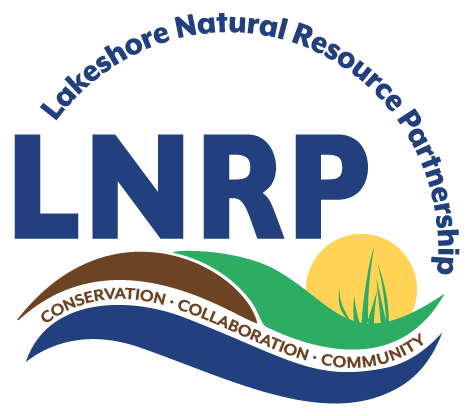Project Update — LNRP Builds on Forest Service Support
A team from Restoration of our Trees Sheboygan (ROOTS) installs trees to replace ash trees impacted by Emerald Ash Borer at a park in Plymouth. (Photo courtesy of ROOTS).
The Lakeshore Natural Resource Partnership has successfully secured a Phase Three grant award for Emerald Ash Borer (EAB) mitigation and coastal ecosystem restoration. The award is administered by the USDA Forest Service funded through the Great Lakes Restoration Initiative (GLRI) under an agreement with the U.S. Environmental Protection Agency (EPA).
Lake Michigan coastal and riparian communities have been significantly impacted by land-use changes; therefore, restoring these unique ecosystems and reducing impacts from land conversion, erosion, pollution, and fragmentation are critical. Forests along the Lake Michigan coastline absorb severe impacts from a changing climate, including intense challenges to birds and wildlife and changes in weather patterns. LNRP will address climate impacts such as warmer, longer growing seasons, milder winters, increased frequency of heavy precipitation, higher fire risk, and the amplification of forest health stressors such as pests and invasive species. The project addresses these challenges by planting diverse, climate adaptable tree species, and performing invasive species control. LNRP will expand tree planting efforts initiated under Phase 1 and 2, to protect Lake Michigan tributary health by using trees to mitigate climate-related stressors such as lower baseflows in summer, increased nutrients inputs, and increased erosion and sedimentation due to more intense precipitation events.
This project takes a climate-adaptive approach to maintain coastal ecosystem function while transitioning forest composition, which will prepare ecosystems for increased drought stress, extreme precipitation and flood events, and invasive species/pathogen impacts. This project proposes to: 1) plant at least 5,000 trees in coastal and riparian communities across the project sites that are better adapted to future conditions; 2) maintain trees for three years according to a maintenance plan; 3) continue implementation of adaptive management to control non-native species within and adjacent to the tree planting units; and 4) continue education and outreach efforts focused on the benefits of tree planting and native restoration.
The projects are funded through the Great Lakes Restoration Initiative (GLRI) under an agreement with the U.S. Environmental Protection Agency. As part of a multi-agency regional working group, the U.S. Forest Service uses GLRI grants to strategically target the biggest threats to the Great Lakes ecosystem and accelerate progress toward shared long-term restoration goals.
EAB Mitigation: $198,000
This project will mitigate emerald ash borer impacts in public parks and conservation properties in Manitowoc and Kewaunee Counties through selective removal of hazardous ash trees that are dead or dying, and planting up to 2,000 species-diverse trees across the watershed.Coastal Ecosystem Restoration: $200,000
This project will install up to 5,000 trees to diversify degraded forests, restore canopy cover, provide critical migratory pathways, enhance riparian and shoreline habitats, and enable ecosystem resiliency within coastal ecosystems in Manitowoc and Kewaunee counties.
LNRP’s overall effort includes the innovative partnership with the Sheboygan Rotary Club and the collaboratively created program titled Restoration of our Trees Sheboygan (ROOTS). The partnership created a Community Investment Fund which provides financial support to Sheboygan County municipalities, villages, and townships. In just three years since the program’s inception, ROOTS and its partner, the Lakeshore Natural Resource Partnership (LNRP), have marshaled Federal and State grants valued at over $1,500,000 for canopy replanting in Sheboygan County and elsewhere along the eastern watershed of Lake Michigan. U.S. Forest Service and Wisconsin DNR reforestation grants specifically benefiting Sheboygan County are currently funding the replacement of tree stock in the Sheboygan Marsh, Esslingen Park, Gerber Lake, and a range of other public land holdings throughout the area. The Sheboygan Rotary Club/ROOTS and LNRP collaboration addressing the impacts of EAB is unique to Sheboygan County and surrounding eastern Wisconsin. With a presentation at the Rotary TriCon Conference in April 2022, LNRP and partners are hoping to expand the program to additional counties in the Lakeshore region.



